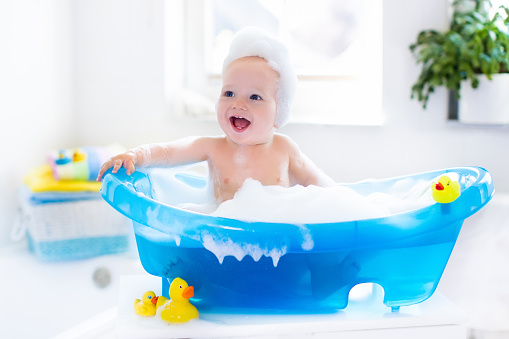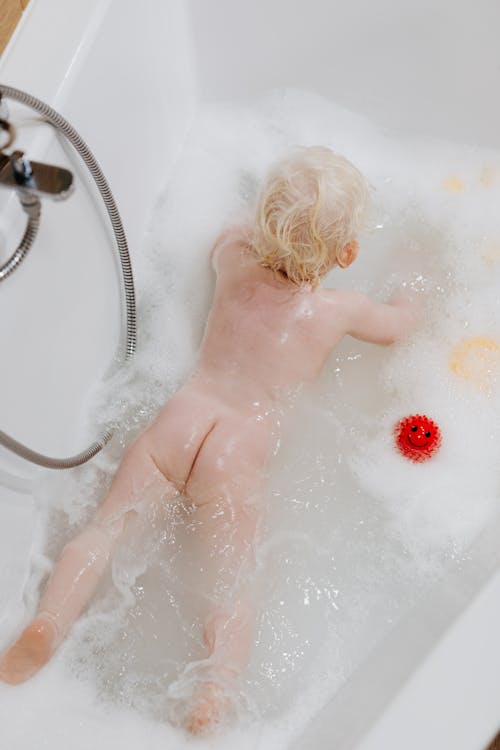Bubbles excite little ones, and as a new mum, you’re trying to make their bath-time as enjoyable as possible. But there’s a lot to discover, and thanks to the internet, you can easily get confounded. For now, let’s pretend that I’ve seen you ask your search engine ‘when can I use bubble bath on my baby?’
Pediatricians, although they don’t all agree, discourage using bubble baths for babies under three years old. Your newborn has a waxy barrier from birth called vernix caseosa, so you don’t need anything for their bath except warm water. While entertaining, soap bubbles dry your tiny tot’s skin and are linked to urinary tract infections, especially in girls.
A baby-safe bubble bath can turn boring old bath-time into a fun, bonding time with your child. But safety first, so you have to think about the toxicity of chemicals, perfumes, and other irritants on your tot’s sensitive skin. However, before you throw in the towel on bubbles, find out what options there are for bubbly bathing.
What Harmful Ingredients Should I Look Out for in Baby Bubble Baths?
According to the US National Academy of Sciences, babies are extremely vulnerable to any harmful chemicals, seeing as their skin is thinner than yours. That means they absorb toxic substances faster, and are also unable to excrete or detoxify against such elements. A baby also can’t talk, often exacerbating any issues or irritation they may be experiencing from using a product.

As a safety-conscious mother of a baby, you’re ever in shock over the lack of transparency with commercial bath and skincare products. It’s well-known that a product will claim to be natural when only less than 1% of its ingredients are indeed organic. You’ll be amazed that the other 99% possibly contains substances unfriendly to your child.
Consider these common ingredients of supposedly marked baby-safe bubble baths, including;
Artificial Fragrance
Hundreds of chemicals make up an artificial fragrance or perfume. The Food and Drug Administration or FDA has no requirements for manufactures to list any of those ingredients unless they’re food additives. That’s due to something called the trade secret confidentiality clause.
As such, many babies get exposed to skin irritation from using scented bath products. Your child can have symptoms that range from dizziness, rashes, sneezing, hives, contact dermatitis, and concentration issues. That situation prevails, especially if your tot is sensitive to any of the chemicals or has asthma.
Phthalates
These are chemical binders and preservers that hold together bubble bath ingredients. Without phthalates, many additives wouldn’t be possible in products like scented bubble baths. However, they’re linked to juvenile asthma, obesity in female children, behavioral issues, early-onset puberty, and male reproductive problems.
Sulfates
Do you know how soaps and other personal care products can create the perfect lather? That’s because of sulfates, sometimes marked as SLES or SLS. These are known to steal natural moisture from your baby’s skin, leading to dryness.
Beyond that, a 2% SLS concentration irritates sensitive baby skin. Household cleaning products can have as high as 30%. Some personal care items sport even higher concentrations of sulfates.
Formaldehyde and Its Releasers
Often used as an antibacterial or preservative agent, formaldehyde is a well-known cancer causer or carcinogenic. You’ll find this chemical in personal care products like bubble baths. Keep a lookout for these ingredients, including;
- Formalin
- Methanediol
- Methyl aldehyde
- Formic aldehyde
- Methylene oxide
- Methanal
- Methylene glycol
Even when formaldehyde in its original form isn’t in use, check to see whether chemical combinations that release it are there. Avoid using products with quaternion-15, Diazolidinyl urea, DMDM hydantoin, and imidazolidinyl urea on your baby.
Can Bubble Bath Cause My Baby a Urinary Tract Infection?
You must limit your baby’s time in bath water to less than ten minutes. That’s a scenario made complex when you are using a bubble bath product to heighten your tot’s bath-time experience. They’ll want to extend their stay on the bubbly warm water, which later contributes to discomfort. But is it true that your child risks a urinary tract infection or UTI from soap bubbles?

Using a bubble bath leaves soap residue trapped in your baby’s urethra or vaginal opening. Whether it’s a boy, but more for girls, bubbles are known to cause UTIs. Being a child, peeing hurts, and they’ll want to hold it in longer, increasing their levels of pain.
A sad fact is that UTIs in babies go unnoticed for a while, or until it becomes a full-blown bacterial infection with fever and inflammation symptoms. It’s a good idea to check on your baby’s urine while noticing if their toilet habits have changed. Symptoms of a urinary tract infection will involve
- Crying while urinating or any other indication that the process is painful
- Urine that has an odd smell
- Persistent unexplained irritability
- Refusal to feed
- Bloody or cloud colored urine
- Diarrhea
- Vomiting
When Can I Start Using a Bubble Bath on My Baby?
It’s best to stay on the side of caution, holding off the bubble bath until your baby is three years or older. At least that’s the advice you’d get from a practitioner when treating a UTI where soap bubbles are involved. You only need to wash your tot at least twice or thrice a week, offering sponge baths or top tails instead alongside after-feeding and diaper change wiping.
When you start including bubbles in their bath, use products that are natural and created for your baby’s sensitive skin. Avoid bubble concoctions that are scented, colored, or have alcohol, and limit bath-time to less than ten minutes.
Rinse off your child’s private area three times, and towel them dry before applying a hypoallergenic baby moisturizer to combat dryness. The fewer skincare products you use, the better.
Conclusion
Every baby is unique, and many of your parenting choices are shaped around what’s safe versus what’s fun. As such, you can use a bubble bath on your child when their body is ready to withstand such substances, preferably after three years of age.
When you do decide to introduce them, keep an eye out for your baby’s reaction. On the merit of your findings, you’ll be able to decide whether to continue or discontinue bubble baths.

I’m Cathrine and I’m a 39-year-old mother of 3 from Utica, New York. And I’m extremely happy you’ve come to visit my hide-out on the web. Here I post about everything related to family-life and usually it will involve babies and lessons I’ve learned over the years from experts, friends, and my own mistakes. So hopefully you will find what i write fun and informational!


